All Exams >
Primary 3 >
General Mathematics for Primary 3 >
All Questions
All questions of Fractions for Primary 3 Exam
The Venn diagram below shows the favourite sports for 20 children.
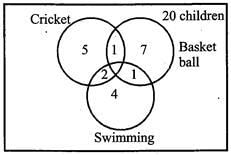
Q. What fraction of students like cricket?- a)1 / 5
- b)2 / 5
- c)1 / 10
- d)3 / 10
Correct answer is option 'B'. Can you explain this answer?
The Venn diagram below shows the favourite sports for 20 children.

Q. What fraction of students like cricket?

Q. What fraction of students like cricket?
a)
1 / 5
b)
2 / 5
c)
1 / 10
d)
3 / 10
|
|
Anjali Gupta answered |
Total no. of students = 20
No. of students who like cricket = 5 + 2 + 1 = 8
Fraction of students who like cricket = 8 / 20 = 25.
No. of students who like cricket = 5 + 2 + 1 = 8
Fraction of students who like cricket = 8 / 20 = 25.
How many triangles should be unshaded so that 2 / 12 of the triangles are shaded?
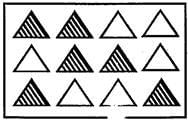
- a)2
- b)3
- c)4
- d)1
Correct answer is option 'C'. Can you explain this answer?
How many triangles should be unshaded so that 2 / 12 of the triangles are shaded?


a)
2
b)
3
c)
4
d)
1
|
|
Anjali Gupta answered |
Total no. of triangles = 12
2 / 12;
So 2 triangles should be shaded so that 2 / 12 of the triangles are shaded
No. of triangles shaded = 6
No. of triangles to be unshaded = 6 - 2 = 4
2 / 12;
So 2 triangles should be shaded so that 2 / 12 of the triangles are shaded
No. of triangles shaded = 6
No. of triangles to be unshaded = 6 - 2 = 4
Nisha got 4 pastries from a bakery. She served 2 of them to the guest's and kept the remaining in the refrigerator. What fraction of pastries are kept in the refrigerator?- a)1 / 4
- b)3 / 4
- c)1 / 3
- d)1 / 2
Correct answer is option 'D'. Can you explain this answer?
Nisha got 4 pastries from a bakery. She served 2 of them to the guest's and kept the remaining in the refrigerator. What fraction of pastries are kept in the refrigerator?
a)
1 / 4
b)
3 / 4
c)
1 / 3
d)
1 / 2
|
|
Pranav Singh answered |
No. of pastries kept in the refrigerator = 4 - 2 = 2
Fraction of pastries kept in the refrigerator = 2 / 4 = 1 / 2.
Fraction of pastries kept in the refrigerator = 2 / 4 = 1 / 2.
Which of the following fractions are considered unlike fractions?- a) 5/8 and 3/8
- b) 1/4 and 1/4
- c) 2/5 and 3/6
- d) 2/3 and 4/3
Correct answer is option 'C'. Can you explain this answer?
Which of the following fractions are considered unlike fractions?
a)
5/8 and 3/8
b)
1/4 and 1/4
c)
2/5 and 3/6
d)
2/3 and 4/3
|
|
Prateek Chakraborty answered |
Understanding Unlike Fractions
Unlike fractions are fractions that have different denominators. This means that the bottom numbers of the fractions are not the same, which makes them "unlike." Let's analyze the given options to identify which pairs of fractions are unlike.
Option A: 5/8 and 3/8
- Both fractions have the same denominator (8).
- Therefore, they are like fractions, not unlike.
Option B: 1/4 and 1/4
- Both fractions are identical, with the same numerator and denominator (1/4).
- These are also like fractions, not unlike.
Option C: 2/5 and 3/6
- The denominators are different (5 and 6).
- This makes them unlike fractions, as they do not share a common denominator.
Option D: 2/3 and 4/3
- Although the denominators are the same (3), the numerators are different (2 and 4).
- These are considered like fractions, as they have the same denominator.
Conclusion
The correct answer is option C (2/5 and 3/6). These fractions are unlike because they have different denominators. Understanding the difference between like and unlike fractions is essential for performing operations such as addition and subtraction, which require a common denominator.
Unlike fractions are fractions that have different denominators. This means that the bottom numbers of the fractions are not the same, which makes them "unlike." Let's analyze the given options to identify which pairs of fractions are unlike.
Option A: 5/8 and 3/8
- Both fractions have the same denominator (8).
- Therefore, they are like fractions, not unlike.
Option B: 1/4 and 1/4
- Both fractions are identical, with the same numerator and denominator (1/4).
- These are also like fractions, not unlike.
Option C: 2/5 and 3/6
- The denominators are different (5 and 6).
- This makes them unlike fractions, as they do not share a common denominator.
Option D: 2/3 and 4/3
- Although the denominators are the same (3), the numerators are different (2 and 4).
- These are considered like fractions, as they have the same denominator.
Conclusion
The correct answer is option C (2/5 and 3/6). These fractions are unlike because they have different denominators. Understanding the difference between like and unlike fractions is essential for performing operations such as addition and subtraction, which require a common denominator.
What fraction of the figure is shaded?

- a)1 / 4
- b)1 / 2
- c)3 / 4
- d)3 / 8
Correct answer is option 'B'. Can you explain this answer?
What fraction of the figure is shaded?


a)
1 / 4
b)
1 / 2
c)
3 / 4
d)
3 / 8
|
|
Akash Tiwari answered |
Count the total number of parts = 8
The number of parts shaded red = 4
Fraction of the figure shaded = 4 / 8 = 1 / 2.
The number of parts shaded red = 4
Fraction of the figure shaded = 4 / 8 = 1 / 2.
How many more parts are to be shaded to make 1 / 2 part shaded?

- a)2
- b)3
- c)4
- d)1
Correct answer is option 'B'. Can you explain this answer?
How many more parts are to be shaded to make 1 / 2 part shaded?


a)
2
b)
3
c)
4
d)
1
|
|
Anjali Gupta answered |
Total no. of parts = 8
No. of parts shaded = 1
No. of parts to be shaded to make 1 / 2 of the circle shaded ⇒ 1 / 2 = 4 / 8 i.e 4 parts.
No. of parts to be shaded more = 4 - 1 = 3.
No. of parts shaded = 1
No. of parts to be shaded to make 1 / 2 of the circle shaded ⇒ 1 / 2 = 4 / 8 i.e 4 parts.
No. of parts to be shaded more = 4 - 1 = 3.
The Venn diagram below shows the favourite drink for 20 students.
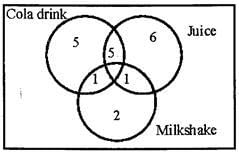
Q. What fraction of students like juice and not milkshake?- a)5 / 20
- b)7 / 20
- c)11 / 20
- d)13 / 20
Correct answer is option 'C'. Can you explain this answer?
The Venn diagram below shows the favourite drink for 20 students.

Q. What fraction of students like juice and not milkshake?

Q. What fraction of students like juice and not milkshake?
a)
5 / 20
b)
7 / 20
c)
11 / 20
d)
13 / 20

|
Focus Academy answered |
Total no. of students = 20
No. of students who like juice and not milk shake = 6 + 5 = 11
Fraction students who like juice and not milk shake =11 / 20
No. of students who like juice and not milk shake = 6 + 5 = 11
Fraction students who like juice and not milk shake =11 / 20
Ravi collected 50 stamps and Surya collected one-fifth of them. How many stamps does Ravi and Surya have in all?- a)60 stamps
- b)10 stamps
- c)40 stamps
- d)20 stamps
Correct answer is option 'A'. Can you explain this answer?
Ravi collected 50 stamps and Surya collected one-fifth of them. How many stamps does Ravi and Surya have in all?
a)
60 stamps
b)
10 stamps
c)
40 stamps
d)
20 stamps
|
|
Anjali Gupta answered |
One-fifth of 50 = 1 / 5 x 50 = 10.
Surya has 10 stamps.
Total stamps w/ Ravi and Surya = 50 + 10 = 60 stamps.
Surya has 10 stamps.
Total stamps w/ Ravi and Surya = 50 + 10 = 60 stamps.
How many squares have to be shaded to make it 1 / 8 shaded?
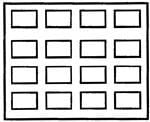
- a)4
- b)3
- c)6
- d)2
Correct answer is option 'D'. Can you explain this answer?
How many squares have to be shaded to make it 1 / 8 shaded?


a)
4
b)
3
c)
6
d)
2
|
|
Anjali Gupta answered |
Total no. of squares = 16
No. of squares to be shaded = 2

No. of squares to be shaded = 2

How do you simplify the fraction 4/8 to its lowest terms?- a) 1/2
- b) 4/2
- c) 2/4
- d) 3/4
Correct answer is option 'A'. Can you explain this answer?
How do you simplify the fraction 4/8 to its lowest terms?
a)
1/2
b)
4/2
c)
2/4
d)
3/4

|
Kds Coaching answered |
To simplify the fraction 4/8, you divide both the numerator and denominator by their greatest common divisor, which is 4. Thus, 4 ÷ 4 = 1 and 8 ÷ 4 = 2, resulting in the simplified fraction 1/2. Simplifying fractions helps in understanding their true value.
Which of the following fractions is a unit fraction?- a) 2/5
- b) 4/8
- c) 1/7
- d) 3/4
Correct answer is option 'C'. Can you explain this answer?
Which of the following fractions is a unit fraction?
a)
2/5
b)
4/8
c)
1/7
d)
3/4

|
Learning Enablers answered |
A unit fraction is defined as a fraction where the numerator is 1. In this case, 1/7 is a unit fraction because its numerator is 1. This concept is fundamental in understanding fractions as it helps identify the smallest portions in fraction representation.
Tick the correct fraction for the given picture
- a)7/3
- b)3/3
- c)3/7
- d)4/4
Correct answer is option 'C'. Can you explain this answer?
Tick the correct fraction for the given picture

a)
7/3
b)
3/3
c)
3/7
d)
4/4
|
|
Glitz Classes answered |
- To determine the correct fraction for the given picture, count both the whole and shaded parts.
- There are 7 equal parts and 3 of these parts are shaded, the fraction representing the shaded portion is 3/7.
- Thus, the correct answer is C: 3/7.
- There are 7 equal parts and 3 of these parts are shaded, the fraction representing the shaded portion is 3/7.
- Thus, the correct answer is C: 3/7.
What fraction of the shapes are triangles?

- a)3 / 12
- b)1 / 13
- c)1 / 12
- d)1 / 16
Correct answer is option 'A'. Can you explain this answer?
What fraction of the shapes are triangles?


a)
3 / 12
b)
1 / 13
c)
1 / 12
d)
1 / 16
|
|
Rhea Reddy answered |
Total no. of shapes = 12
No. of triangles = 3
Fraction of triangles = 3 / 12.
No. of triangles = 3
Fraction of triangles = 3 / 12.
If a chocolate bar is divided into 2 equal pieces, what fraction does each piece represent?- a) 1/3
- b) 1/2
- c) 1/4
- d) 2/3
Correct answer is option 'B'. Can you explain this answer?
If a chocolate bar is divided into 2 equal pieces, what fraction does each piece represent?
a)
1/3
b)
1/2
c)
1/4
d)
2/3
|
|
Riya Singh answered |
When a chocolate bar is divided into 2 equal pieces, each piece represents 1/2 of the whole. This concept is fundamental in understanding fractions, especially in sharing scenarios.
Which of the following fractions is an example of an equivalent fraction to 1/2?- a) 1/3
- b) 3/5
- c) 4/8
- d) 2/4
Correct answer is option 'D'. Can you explain this answer?
Which of the following fractions is an example of an equivalent fraction to 1/2?
a)
1/3
b)
3/5
c)
4/8
d)
2/4
|
|
Riya Singh answered |
The fractions 1/2, 2/4, and 4/8 are all equivalent because they represent the same part of a whole despite having different numerators and denominators. Understanding equivalent fractions is essential for simplifying and comparing fractions.
If a cake is divided into 8 equal parts and someone takes 3 parts, how can the fraction of the cake taken be expressed?- a) 1/8
- b) 3/8
- c) 5/8
- d) 1/2
Correct answer is option 'B'. Can you explain this answer?
If a cake is divided into 8 equal parts and someone takes 3 parts, how can the fraction of the cake taken be expressed?
a)
1/8
b)
3/8
c)
5/8
d)
1/2

|
Learning Enablers answered |
When a cake is divided into 8 equal parts and 3 parts are taken, the fraction representing the portion taken is 3/8. This shows that out of the 8 equal slices, 3 have been consumed. Understanding fractions in this way can help in real-life sharing situations.
To check if two fractions are equivalent, which mathematical operation can be used?- a) Add the numerators.
- b) Divide the numerators by the denominators.
- c) Subtract the denominators.
- d) Multiply the numerators by the denominators.
Correct answer is option 'D'. Can you explain this answer?
To check if two fractions are equivalent, which mathematical operation can be used?
a)
Add the numerators.
b)
Divide the numerators by the denominators.
c)
Subtract the denominators.
d)
Multiply the numerators by the denominators.

|
Dr Manju Sen answered |
To check if two fractions are equivalent, you multiply the numerator of the first fraction by the denominator of the second and vice versa. If the products are equal, the fractions are equivalent. For example, checking if 2/4 and 4/8 are equivalent involves confirming that 2 × 8 = 16 and 4 × 4 = 16.
Which fraction is odd one out?

- a)

- b)

- c)

- d)

Correct answer is option 'D'. Can you explain this answer?
Which fraction is odd one out?


a)

b)

c)

d)

|
|
Pranav Singh answered |


So,

is odd one out.
Which shows the fraction in correct order?

- a)A
- b)B
- c)C
- d)D
Correct answer is option 'A'. Can you explain this answer?
Which shows the fraction in correct order?


a)
A
b)
B
c)
C
d)
D
|
|
Pranav Singh answered |
1 / 2 = 2 / 4
So, 1 / 4 < 2 / 4 < 3 / 4, hence Figure A is correct.
So, 1 / 4 < 2 / 4 < 3 / 4, hence Figure A is correct.
What is the role of the numerator in a fraction?- a) It indicates how many parts we have.
- b) It shows the total amount of the whole.
- c) It represents the total number of items in a collection.
- d) It shows how many equal parts the whole is divided into.
Correct answer is option 'A'. Can you explain this answer?
What is the role of the numerator in a fraction?
a)
It indicates how many parts we have.
b)
It shows the total amount of the whole.
c)
It represents the total number of items in a collection.
d)
It shows how many equal parts the whole is divided into.
|
|
Edu Impact answered |
The numerator is the top number in a fraction, which indicates how many parts of the whole are being considered. For example, in the fraction 3/4, the numerator is 3, meaning we have three parts of a total of four. Understanding the role of the numerator helps in grasping the concept of fractions as parts of a whole.
What fraction represents half of a whole?- a) 1/4
- b) 2/3
- c) 1/2
- d) 1/3
Correct answer is option 'C'. Can you explain this answer?
What fraction represents half of a whole?
a)
1/4
b)
2/3
c)
1/2
d)
1/3

|
Dr Manju Sen answered |
Half of a whole is represented by the fraction 1/2, meaning that the whole is divided into two equal parts, and one of those parts is taken. This is a fundamental concept in fractions that applies to many real-world situations, such as sharing food.
What fraction represents three equal parts of a whole that is divided into four equal parts?- a) 2/4
- b) 1/4
- c) 1/2
- d) 3/4
Correct answer is option 'D'. Can you explain this answer?
What fraction represents three equal parts of a whole that is divided into four equal parts?
a)
2/4
b)
1/4
c)
1/2
d)
3/4

|
Learning Enablers answered |
The fraction representing three equal parts of a whole divided into four equal parts is 3/4. This illustrates the concept of fractions in terms of parts of a whole, which is fundamental in various real-life contexts such as cooking and sharing.
If you have a fraction 5/6 and you subtract 1/6, what is the result?- a) 4/6
- b) 6/6
- c) 5/7
- d) 5/5
Correct answer is option 'A'. Can you explain this answer?
If you have a fraction 5/6 and you subtract 1/6, what is the result?
a)
4/6
b)
6/6
c)
5/7
d)
5/5
|
|
Glitz Classes answered |
To subtract like fractions, you subtract the numerators while keeping the denominator the same. Thus, 5/6 - 1/6 = (5 - 1)/6 = 4/6. This result can also be simplified further to 2/3 if needed.
What is the fraction of red flowers if there are 1 red and 2 yellow flowers in a collection of 3 flowers?- a) 2/3
- b) 1/4
- c) 1/2
- d) 1/3
Correct answer is option 'D'. Can you explain this answer?
What is the fraction of red flowers if there are 1 red and 2 yellow flowers in a collection of 3 flowers?
a)
2/3
b)
1/4
c)
1/2
d)
1/3
|
|
Glitz Classes answered |
In a collection of 3 flowers, with 1 red flower, the fraction representing the part of red flowers is 1/3. This demonstrates how fractions can represent parts of a whole in a collection, which is a useful skill in various applications.
The table C shows the fraction of stationery items kept in a bag. If there are 24 items in the bag. How many pencils are there?
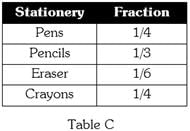
- a)6 Pencils
- b)8 Pencils
- c)3 Pencils
- d)4 Pencils
Correct answer is option 'B'. Can you explain this answer?
The table C shows the fraction of stationery items kept in a bag. If there are 24 items in the bag. How many pencils are there?


a)
6 Pencils
b)
8 Pencils
c)
3 Pencils
d)
4 Pencils
|
|
Anjali Gupta answered |
Total no. of items = 24
No. of Pencils = 1 / 3 of 24 = 1 / 3 x 24 = 8 Pencils.
No. of Pencils = 1 / 3 of 24 = 1 / 3 x 24 = 8 Pencils.
How many equal parts does the shape below have?

- a)0
- b)3
- c)2
- d)4
Correct answer is option 'C'. Can you explain this answer?
How many equal parts does the shape below have?


a)
0
b)
3
c)
2
d)
4
|
|
Rhea Reddy answered |
The dotted line divided the heart shape in 2 equal parts.
If a fraction is described as three-fourths, what does it mean?- a) 4/3
- b) 3/4
- c) 1/4
- d) 1/3
Correct answer is option 'B'. Can you explain this answer?
If a fraction is described as three-fourths, what does it mean?
a)
4/3
b)
3/4
c)
1/4
d)
1/3
|
|
Edu Impact answered |
The term three-fourths refers to the fraction 3/4, which indicates that three parts out of a total of four equal parts are being considered. This fraction helps in visualizing portions of a whole, commonly used in recipes and sharing scenarios.
How many equal parts does the shape below have? 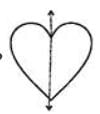
- a)1
- b)2
- c)3
- d)4
Correct answer is option 'B'. Can you explain this answer?
How many equal parts does the shape below have?

a)
1
b)
2
c)
3
d)
4
|
|
Anjali Gupta answered |
The dotted line divided the heart shape into 2 equal parts
How do you add the fractions 2/5 and 1/5?- a) 5/5
- b) 2/10
- c) 1/5
- d) 3/5
Correct answer is option 'D'. Can you explain this answer?
How do you add the fractions 2/5 and 1/5?
a)
5/5
b)
2/10
c)
1/5
d)
3/5
|
|
Riya Singh answered |
To add like fractions, you simply add the numerators while keeping the denominator the same. Thus, 2/5 + 1/5 = (2 + 1)/5 = 3/5. This principle is crucial for performing operations with fractions correctly.
What type of fraction has a numerator larger than its denominator?- a) Like fraction
- b) Proper fraction
- c) Improper fraction
- d) Unit fraction
Correct answer is option 'C'. Can you explain this answer?
What type of fraction has a numerator larger than its denominator?
a)
Like fraction
b)
Proper fraction
c)
Improper fraction
d)
Unit fraction

|
Learning Enablers answered |
An improper fraction is one where the numerator is larger than the denominator, such as 7/4. This concept is important in understanding the relationship between different types of fractions, particularly when converting between mixed numbers and improper fractions.
What type of fractions have the same denominator?- a) Like fractions
- b) Mixed fractions
- c) Unlike fractions
- d) Improper fractions
Correct answer is option 'A'. Can you explain this answer?
What type of fractions have the same denominator?
a)
Like fractions
b)
Mixed fractions
c)
Unlike fractions
d)
Improper fractions
|
|
Riya Singh answered |
Fractions that share the same denominator are termed like fractions. An example is 1/4 and 3/4, where both fractions have the denominator of 4. Understanding this classification helps simplify addition and subtraction of fractions.
What happens when you subtract a fraction from itself?- a) It results in 0.
- b) It results in the original fraction.
- c) It results in a larger fraction.
- d) It results in 1.
Correct answer is option 'A'. Can you explain this answer?
What happens when you subtract a fraction from itself?
a)
It results in 0.
b)
It results in the original fraction.
c)
It results in a larger fraction.
d)
It results in 1.
|
|
Riya Singh answered |
When you subtract a fraction from itself, the result is always 0. For example, if you have 3/5 and subtract 3/5, you get 0. This concept is fundamental in understanding properties of operations with fractions.
If Zainab divides a pizza into 4 equal parts and takes 1 part, what fraction of the pizza is left?- a) 1/2
- b) 2/4
- c) 3/4
- d) 1/4
Correct answer is option 'C'. Can you explain this answer?
If Zainab divides a pizza into 4 equal parts and takes 1 part, what fraction of the pizza is left?
a)
1/2
b)
2/4
c)
3/4
d)
1/4

|
Dr Manju Sen answered |
If Zainab takes 1 out of 4 equal parts of the pizza, she has taken 1/4, leaving her with 3/4 of the pizza. This illustrates the concept of fractions in real-life sharing scenarios.
What is the result of adding the fractions 3/8 and 2/8?- a) 1/4
- b) 5/8
- c) 1/2
- d) 3/4
Correct answer is option 'B'. Can you explain this answer?
What is the result of adding the fractions 3/8 and 2/8?
a)
1/4
b)
5/8
c)
1/2
d)
3/4

|
Learning Enablers answered |
When adding like fractions, you simply add the numerators while keeping the denominator the same. Therefore, 3/8 + 2/8 = (3 + 2)/8 = 5/8. This operation is foundational in fraction arithmetic.
The table B shows the number of vegetable kept in a basket. What fraction of vegetables without Carrots and Onions?
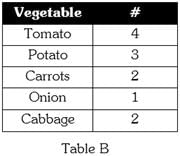
- a)1/12
- b)4/13
- c)4/15
- d)9/12
Correct answer is option 'D'. Can you explain this answer?
The table B shows the number of vegetable kept in a basket. What fraction of vegetables without Carrots and Onions?


a)
1/12
b)
4/13
c)
4/15
d)
9/12
|
|
Anjali Gupta answered |
Total no. of vegetables = 12
No. of vegetables that care not carrots and onions = 12 - (4 + 3 + 2) = 3.
Fraction of veg that are not carrots onions = 3 / 12
No. of vegetables that care not carrots and onions = 12 - (4 + 3 + 2) = 3.
Fraction of veg that are not carrots onions = 3 / 12
left = 9/12
How many equal parts does the figure below have?

- a)2
- b)3
- c)4
- d)0
Correct answer is option 'D'. Can you explain this answer?
How many equal parts does the figure below have?


a)
2
b)
3
c)
4
d)
0
|
|
Rhea Reddy answered |
The dotted lines divide the shape in 4 parts.
However none of the parts are equal.
Hence there are 0 equal parts in the figure.
However none of the parts are equal.
Hence there are 0 equal parts in the figure.
What is the first step in solving a word problem involving fractions?- a) Add the fractions.
- b) Identify the fractions involved.
- c) Simplify the fractions.
- d) Write the fractions in lowest terms.
Correct answer is option 'B'. Can you explain this answer?
What is the first step in solving a word problem involving fractions?
a)
Add the fractions.
b)
Identify the fractions involved.
c)
Simplify the fractions.
d)
Write the fractions in lowest terms.

|
Dr Manju Sen answered |
The first step in solving any word problem that involves fractions is to identify the fractions involved. Understanding what fractions you are working with allows you to determine the necessary operations, whether they are addition, subtraction, or others.
Chapter doubts & questions for Fractions - General Mathematics for Primary 3 2025 is part of Primary 3 exam preparation. The chapters have been prepared according to the Primary 3 exam syllabus. The Chapter doubts & questions, notes, tests & MCQs are made for Primary 3 2025 Exam. Find important definitions, questions, notes, meanings, examples, exercises, MCQs and online tests here.
Chapter doubts & questions of Fractions - General Mathematics for Primary 3 in English & Hindi are available as part of Primary 3 exam.
Download more important topics, notes, lectures and mock test series for Primary 3 Exam by signing up for free.
General Mathematics for Primary 3
15 videos|82 docs|29 tests
|

Contact Support
Our team is online on weekdays between 10 AM - 7 PM
Typical reply within 3 hours
|
Free Exam Preparation
at your Fingertips!
Access Free Study Material - Test Series, Structured Courses, Free Videos & Study Notes and Prepare for Your Exam With Ease

 Join the 10M+ students on EduRev
Join the 10M+ students on EduRev
|

|
Create your account for free
OR
Forgot Password
OR
Signup on EduRev and stay on top of your study goals
10M+ students crushing their study goals daily
































